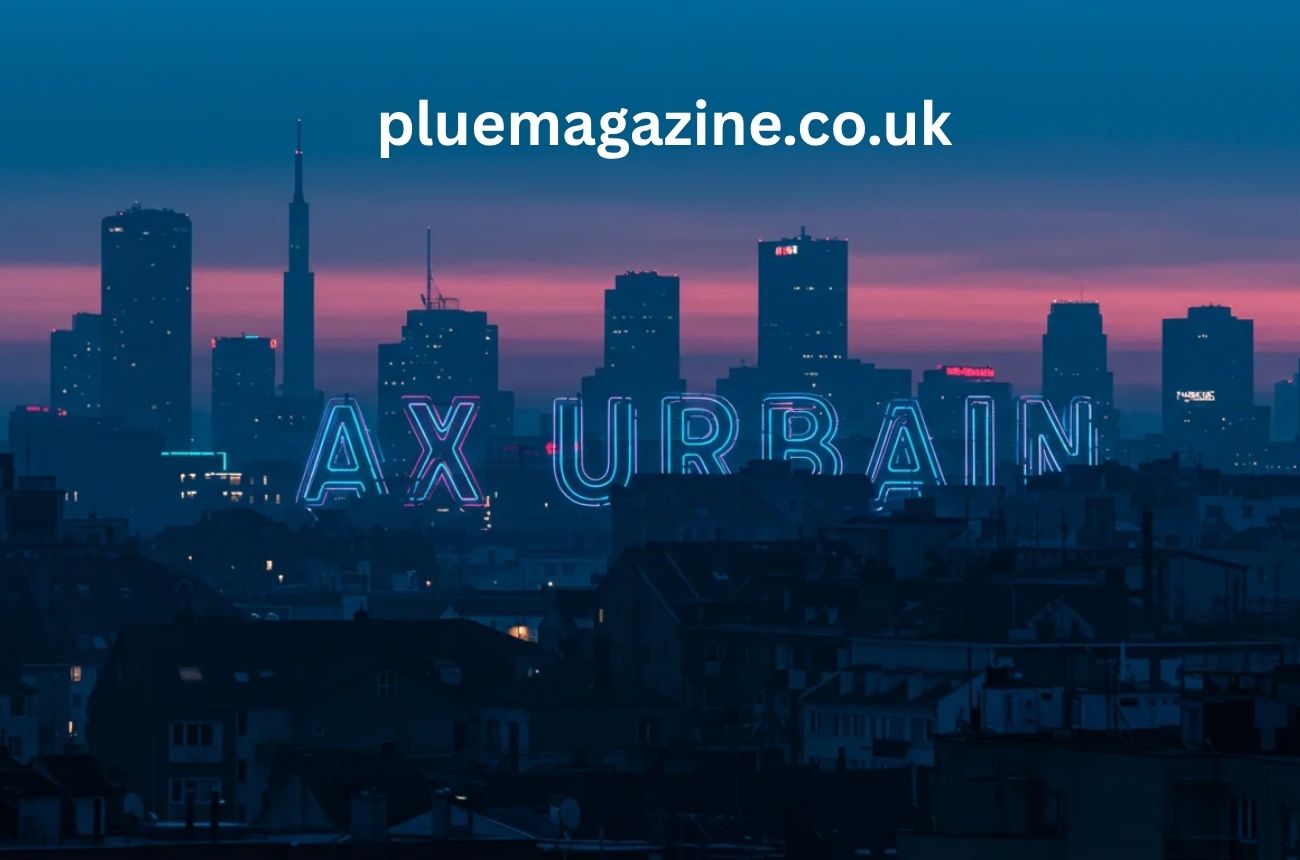Blog
How Axurbain Transforms Public Spaces — Real-World Uses

In recent years, Axurbain has emerged as a transformative concept redefining the relationship between technology, architecture, and public spaces. More than a design movement, Axurbain represents a philosophy of intelligent urban innovation, combining sustainable development, smart technologies, and human-centric design. As cities face growing challenges — from overpopulation and pollution to energy crises — the Axurbain model seeks to create connected, responsive, and inclusive environments that support both ecological balance and human well-being.
1. Understanding the Concept of Axurbain
Axurbain can be understood as a fusion of “urban” design and advanced technology, focusing on how cities can evolve into living, adaptive organisms. It integrates data analytics, AI-driven architecture, and eco-resilient materials to build spaces that respond dynamically to citizens’ needs. Unlike traditional urban planning, which focuses primarily on physical infrastructure, Axurbain incorporates digital intelligence — sensors, IoT systems, and real-time feedback mechanisms — to manage energy use, traffic flow, and public services efficiently.
2. The Core Philosophy Behind Axurbain
At the heart of Axurbain lies the principle of balance between nature, people, and innovation. The approach acknowledges that cities are more than collections of buildings — they are ecosystems. Axurbain initiatives prioritize green design, accessibility, and cultural identity, ensuring that each public space enhances social interaction while maintaining environmental integrity. Its philosophy also embraces adaptability: spaces are designed to evolve based on community needs and environmental data rather than remain static.
3. The Technological Foundation of Axurbain

The foundation of Axurbain’s success is its technological backbone. Through advanced Internet of Things (IoT) networks, machine learning algorithms, and smart sensors, Axurbain-enabled cities can monitor their environments in real-time. Streetlights, for example, may dim when no pedestrians are nearby, or public benches may include solar charging stations. These innovations not only improve efficiency but also promote sustainable behavior by citizens. The use of data visualization tools helps urban planners assess environmental impact and optimize design continuously.
4. Designing Human-Centric Public Spaces
Unlike conventional urban development that prioritizes economic return, Axurbain places humans at the center of its design philosophy. The layout of parks, squares, and pedestrian zones is planned with well-being and inclusivity in mind. By leveraging behavioral data and community feedback, designers create flexible zones that accommodate diverse activities — from social gatherings and outdoor art to exercise and meditation. This adaptability helps people feel emotionally connected to their surroundings, fostering a sense of belonging in urban environments.
5. Sustainability as a Core Driver
One of the most compelling elements of Axurbain is its commitment to sustainability. Every project under this model strives to reduce its carbon footprint and integrate renewable energy sources. The use of vertical gardens, rainwater harvesting systems, and biodegradable construction materials are common. Additionally, Axurbain promotes local resource utilization — reducing long supply chains and supporting regional economies. In doing so, it not only combats climate change but also strengthens community resilience against environmental disruptions.
6. Social Connectivity Through Smart Infrastructure
Axurbain enhances social connectivity by embedding smart infrastructure that encourages human interaction. For example, interactive digital kiosks can display local art, history, or cultural events. Public seating areas may include Wi-Fi-enabled workstations, encouraging outdoor collaboration. In cities where isolation is a growing problem, these digital touchpoints create shared experiences, bridging the gap between technology and togetherness. Furthermore, community apps allow residents to participate in local decision-making, ensuring civic engagement remains at the core of development.
7. Real-World Applications of Axurbain

Cities worldwide are experimenting with Axurbain-inspired designs. In Europe, for instance, urban innovation projects have transformed old industrial zones into smart green districts that adapt to community usage patterns. In Asia, municipalities are deploying AI-based waste management systems that monitor collection needs in real-time, drastically reducing environmental waste. Meanwhile, in North America, Axurbain concepts are being used in revitalizing downtown areas through interactive public installations and green architecture that combines urban functionality with artistic expression.
8. Axurbain’s Role in Reviving Aging Infrastructure
A key advantage of Axurbain is its potential to revitalize aging infrastructure. Many older cities struggle with outdated layouts and inefficient systems. Axurbain integrates digital layers onto these existing frameworks, breathing new life into historic districts without erasing their heritage. Through adaptive lighting, environmental monitoring, and renewable microgrids, urban planners can retrofit old structures into energy-efficient, user-friendly spaces. This revitalization allows cities to preserve their past while preparing for the future.
9. The Economic Impact of Axurbain Innovation
From an economic standpoint, Axurbain presents numerous benefits. By emphasizing efficiency and sustainability, cities can reduce operational costs in utilities and maintenance. Furthermore, the creation of smart districts attracts investors, startups, and innovators, generating employment and stimulating local economies. The demand for professionals skilled in AI, design thinking, and environmental sciences also rises, creating new economic ecosystems within the city’s core. The Axurbain model, therefore, is not just about beautification — it is a driver of long-term economic growth.
10. Community Participation in Axurbain Projects
A defining trait of successful Axurbain projects is citizen participation. Communities are invited to co-create their public spaces through digital feedback tools and workshops. This participatory process ensures that every square meter of urban land reflects local needs. People become active stakeholders rather than passive observers. By empowering citizens to take part in design and maintenance, Axurbain fosters civic pride and ensures long-term sustainability of the public space.
11. The Cultural Dimension of Axurbain

Axurbain doesn’t overlook the cultural and artistic dimensions of urban life. It integrates heritage elements into modern architecture, ensuring that development remains authentic to local identity. For example, public installations may feature local artists’ works powered by solar energy, or augmented reality guides may narrate stories of historic landmarks. By blending tradition with innovation, Axurbain preserves the cultural memory of a city while steering it toward a digital future.
12. Future Prospects of Axurbain
The next frontier for Axurbain lies in AI-driven predictive urban management. Future cities may use autonomous drones for environmental monitoring, AI models for predicting population density, and virtual twin simulations for testing infrastructure performance. As 5G and quantum computing become mainstream, Axurbain will evolve into a completely responsive urban framework — capable of adapting to citizens’ behavior, climate conditions, and even global crises. The integration of blockchain could ensure data transparency and security in smart city governance.
13. Conclusion
In summary, Axurbain is redefining how cities grow, breathe, and connect with their citizens. It blends technological intelligence with ecological ethics and cultural awareness, creating public spaces that are alive, sustainable, and human-focused. As more urban centers adopt these principles, the world moves closer to achieving cities that not only function efficiently but also inspire creativity, harmony, and inclusivity. Axurbain is not just a trend — it is the blueprint for the cities of tomorrow.
Five Frequently Asked Questions (FAQs)
1. What does the term “Axurbain” mean?
Axurbain refers to a modern urban innovation model that merges smart technology, sustainable design, and human-centered planning. The term emphasizes transforming cities into adaptive, data-driven ecosystems that promote well-being, efficiency, and environmental responsibility.
2. How does Axurbain benefit everyday citizens?
Citizens experience more convenient, efficient, and enjoyable urban living. From reduced energy waste to cleaner air and enhanced mobility, Axurbain uses real-time data and automation to create safer, smarter, and greener environments that improve the quality of daily life.
3. What technologies are essential for Axurbain development?
Axurbain relies on interconnected systems such as the Internet of Things (IoT), artificial intelligence (AI), and renewable energy solutions. These technologies allow public spaces to “think” and respond intelligently — adjusting lighting, waste management, and air quality systems based on real-time conditions.
4. Can Axurbain concepts be applied to existing cities?
Yes. One of Axurbain’s strengths lies in its flexibility. By integrating digital networks and sustainable retrofitting techniques, older cities can adopt Axurbain principles without major reconstruction. This approach revitalizes historic areas while maintaining cultural authenticity.
5. What is the future potential of Axurbain in global urban planning?
The potential is vast. As climate change and urbanization accelerate, Axurbain provides a sustainable framework for building resilient, data-driven cities. Future innovations like AI governance, urban twins, and decentralized energy grids will make Axurbain the cornerstone of 21st-century urban planning.
-

 Celebrity8 months ago
Celebrity8 months agoWho Is Elizabeth Buckley Harrold O’Donnell? A Closer Look at Lawrence O’Donnell’s Family
-

 Celebrity8 months ago
Celebrity8 months agoNathaniel Mandrell Dudney: Insights into Barbara Mandrell’s Family Life
-

 Celebrity8 months ago
Celebrity8 months agoWho Is Vera Davich? A Deep Dive into Her Life and Relationship with Scott Patterson
-

 Celebrity8 months ago
Celebrity8 months agoTalia Elizabeth Jones: Exploring Her Connection to Davy Jones
















